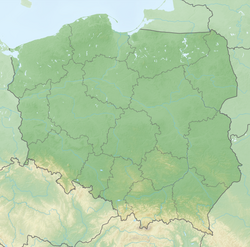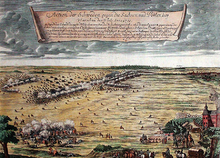Battle of Rakowitz
| date | July 21, Sweden / July 31, 1705 greg. |
|---|---|
| place | Wola , Warsaw , Poland |
| output | Victory of the Swedes |
| consequences | Implementation of the election of Stanislaus I as the new Polish king and Warsaw Peace |
| Parties to the conflict | |
|---|---|
| Commander | |
| Troop strength | |
| 6,000 Poles 3,500 Saxons |
over 2,000 Swedes |
| losses | |
|
500 dead |
150 dead |
1st phase: Swedish dominance (1700–1709)
Riga I • Jungfernhof • Varja • Pühhajoggi • Narva • Pechora • Düna • Rauge • Erastfer • Hummelshof • Embach • Tartu • Narva II • Wesenberg I • Wesenberg II
Arkhangelsk • Lake Ladoga • Nöteborg • Nyenschanz • Neva • Systerbäck • Petersburg • Vyborg I • Porvoo • Neva II • Koporje II • Kolkanpää
Vilnius • Salads • Jacobstadt • Walled Courtyard • Mitau • Grodno I • Olkieniki • Nyaswisch • Klezk • Ljachavichy
Klissow • Pułtusk • Thorn • Lemberg • Warsaw • Posen • Punitz • Tillendorf • Rakowitz • Praga • Fraustadt • Kalisch
Grodno II • Golovchin • Moljatichi • Rajowka • Lesnaja • Desna • Baturyn • Koniecpol • Weprik • Opischnja • Krasnokutsk • Sokolki • Poltava I • Poltava II
2nd phase: Sweden on the defensive (1710–1721)
Riga II • Vyborg II • Pernau • Kexholm • Reval • Hogland • Pälkäne • Storkyro • Nyslott • Hanko
Helsingborg • Køge Bay • Gulf of Bothnia • Frederikshald I • Dynekilen Fjord • Gothenburg I • Strömstad • Trondheim • Frederikshald II • Marstrand • Ösel • Gothenburg II • Södra Stäket • Grönham • Sundsvall
Elbing • Wismar I • Lübow • Stralsund I • Greifswalder Bodden I • Stade • Rügen • Gadebusch • Altona • Tönning II • Stettin • Fehmarn • Wismar II • Stralsund II • Jasmund • Peenemünde • Greifswalder Bodden II • Stresow
The Battle of Rakowitz , also known as the Battle of Warsaw , was a battle of the Great Northern War and took place on July 21, Swedish / July 31, 1705 greg. in what is now the Warsaw district of Wola . In this battle an army consisting of Saxony and Poland was defeated by a Swedish army five times smaller .
The army of the Poles and Saxons, led by Lieutenant General Otto Arnold Paykull , had a total strength of 9,500 men (6,000 of them Poles, 3,500 Saxons). The Swedes under Lieutenant General Karl Nieroth only had 2000 men.
prehistory
In 1699 was in Moscow between Tsar Peter I , King August II. Of Poland and Frederick IV. Of Denmark in the Treaty of Preobrazhenskoye District an alliance against the Kingdom of Sweden concluded with the aim of weakening the Swedish position in the Baltic region. The Great Northern War that then broke out , however, developed differently for the Alliance than planned. Instead of the hoped-for territorial gains in the Baltic States , the Wettin king of Poland, August II, did not have any military successes against King Charles XII. of Sweden . The military situation developed so badly for the alliance that, from 1702, Polish territory immediately became a deployment area and theater of war for Swedish troops.
After the victory of Krakow in 1702 and the conquest of Thorn by Charles XII. the military and economic position of the Polish King and Saxon Elector August II became hopeless. Due to the devastating economic consequences, the Polish nobility now split into different camps. The Swedish-friendly Confederation of Warsaw , founded in 1704, pushed for an end to the war. Your joined Stanislaus Leszczynski on. From 1704 he led the peace negotiations with the Swedish King Karl XII, who gained confidence in Leszczyński and re-elected him as the Polish king on July 12, 1704 . supported.
The first half of 1705 took place in Poland without any military events. The city of Rawitsch is the headquarters of the Swedish army under the command of King Charles XII. At the time it was decided that the candidate Charles XII. Stanislaus Leszczyński to be crowned the new Polish king. This coronation was to take place in July 1705. His opponents then gathered a force of 10,000 men in the capital of Poland, Warsaw, to prevent this coronation. To ensure the safety of the heir to the throne, Charles XII. his Lieutenant General Karl Nieroth with a 2,000-strong force to Warsaw.
For the Swedes, securing the succession to the throne was so important, because the peace negotiations with Poland that had started at the time could only be concluded with their preferred candidate. The actual Polish king, the Wettin August II, was ready to negotiate peace with Sweden at the time, but the Swedes, for their part, wanted to see a more docile candidate for the Polish throne. Thus, with the dethronement of August II, the Swedes saw the only possibility of creating peace in their favor.
course
The Swedish army, under the command of Lieutenant General Nieroth, was ready outside the city walls of Warsaw. It consisted of three cavalry regiments and 60 infantrymen.
The Saxon-Polish army marched on the road from Błonie to Warsaw. This army was almost five times the size of the Swedish forces. The Saxon Lieutenant General Otto Arnold Paykull commanded a total of 3,500 Saxon cuirassiers and 6,000 Polish cavalrymen. The army stopped at Wola , a Warsaw suburb, and formed a compact battle line along the road from Rakowicz to Warsaw. In the center stood the Saxons under Paykul and his subordinate Major General Daniel Bodo von der Schulenburg (a brother of the better-known General Johann Matthias von der Schulenburg ), and on the wings the Polish riders waited, led by six noble marshals.
On July 21st, Sweden / July 31st, Greg. Nieroth decided to attack. To this end, he divided his line into two wings of its own, as the opposing Polish-Saxon battle line far surpassed the Swedish one. At 8:00 a.m. the advance of the Swedish formations began. The Swedish cavalry rode the attack at high speed and broke into the enemy line with great intensity. In this first attack on the right side, the Swedes succeeded in routing 3,000 Lithuanian cavalrymen, who were shocked by the intensity of the attack wave, from the battlefield.
At the other points, however, the Swedes were met with stubborn resistance. Lieutenant General Paykull tried to use the gap that opened up between the two Swedish wings. Six Saxon squadrons managed to cross the gap to swing left behind the enemy line and fall in the rear of the Swedes there, disrupting their battle line. However, the Swedes managed to push back the Saxons. On the Swedish left wing, the Swedish cavalrymen attacked the 3,000 Saxons there with a sustained battle frenzy until the Saxons could not hold their position, turned and withdrew. Shortly afterwards the Saxons stopped and formed a new battle line. Thereupon a stubborn battle developed again with the Swedes, who also won this.
After six hours the battle was over. The Swedes suffered 150 dead and 150 wounded. In the case of the Poles and Saxons there were about 500 dead and around 1,000 wounded.
consequences
On October 4th, 1705 Stanislaus Leszczyński was crowned the new Polish king. On November 18, 1705, Poland made peace with Sweden.
literature
- O. Haintz: King Karl XII. von Sweden - Sweden's struggle for supremacy in Northern and Eastern Europe 1697–1709 , Vol. 1 (1936), Berlin 1958.
Web links
- detailed description of the battle ( PDF file; 4.43 MB)
- Page 289 from: Theatrum Europaeum Vol.17 ; Description of the battle from 1720 (PDF file; 233 kB)
- Page 290 from: Theatrum Europaeum Vol.17 ; Description of the battle from 1720 (PDF file; 219 kB)


